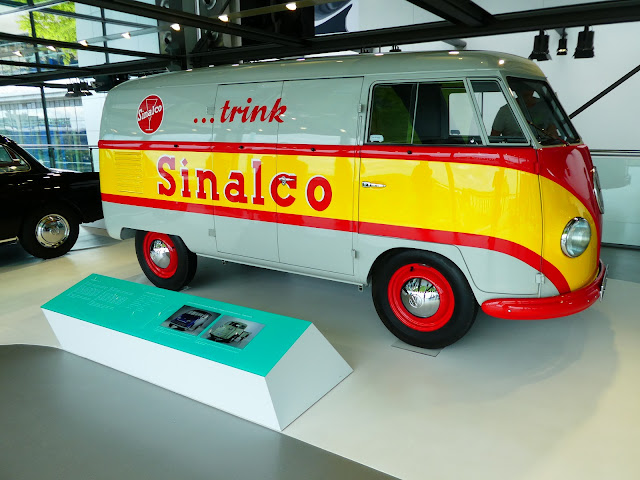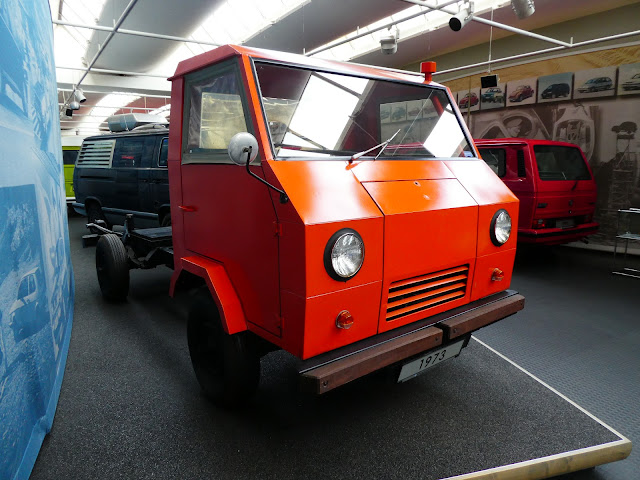
Entry hall interior

Looking towards the Audi pavilion and the greenhouse tunnel.

The Seat pavilion

The Autostadt Ritz Hotel

Ducati exhibit

Premium Clubhouse overshadowed by the smokestacks of the factory.

Porsche pavilion

Display inside the Porsche pavilion

The Zeithaus Museum
The Zeithaus Museum is organized into two collections. The Design Icons collection showcases historically important vehicles in a contemporary art setting spread over three floors. Each car is extensively documented, explaining its importance and its place in history. It is, in my opinion, probably the best auto museum in the world.

1912 Bugatti Landau. A typical of example of early cars with a coach-like body. Additionally, cars like this were intended to be driven by a chauffeur.

1924 Lancia Lambda. The Lancia Lambda pioneered the low slung chassis and load bearing body. It also featured independent suspension and four-wheel brakes. Its long, low look in an era when bigger was better, didn't do any favours.

1924 Hanomag 2/10PS 'Kommisbrot' reintroduced the idea of the rear engine and the budget 'people's' car. It would soon be copied and improved on, most famously by Volkswagen themselves.

1931 MG M-Type Midget. A British classic sportscar that was small and cheap enough for a well-to-do young man.

1932 Hispanio-Suiza cabriolet. A luxury style icon of the Great Gatsby era.
1938 BMW 327. The streamlining era of the 1930s is epitomized by the beautiful BMW 327 roadster. BMW had grown from very humble beginnings manufacturing Austin 7's under license to become a premium sportscar maker by this time.

1939 Bugatti Type 57SC Atlantic. THE pinnacle of the pre-war French streamline movement. Only four examples were built with this luxury, custom bodywork. This is a replica body fitted over a Type 57 chassis.

1950 Borgward Hansa 1500. Carl Borgward introduced Germany to the ponton body style in 1949. Within a decade the ponton body would become the standard.

1959 Cadillac Eldorado. The epitome of American post-war styling - wings, fins, huge size. A whale on wheels.

The archetypical Porsche 911. Taking Volkswagen's budget car heritage to sportscar luxury.

1960s and 70s sports performance for the people. The Jaguar E-Type and the Opel Capri.

1967 Lamborghini Miura

Bentley

Bentley and Volkswagen

Volkswagen Beetle in gold and diamonds

1964 Volkswagen T2 Transport and Beach Buggy.

Icons of streamlining. The unlucky Chrysler Airflow was too advanced for customers when introduced in 1934, which led to its restyling to a more conventional appearance. This it the 1937 model.

Perfection on wheels. Ferry Porsche's immortal 1952 Porsche 356A.


1956 Citroen DS. Possibly the most amazing car ever built. Unveiled at the Paris Motor Show in 1955, the DS was so far ahead of its time it could have been designed by aliens (or the French).
The Car Collection

The Zeithaus museum collection is displayed across from the Design Icons in a three story glass pavilion. Like the Design Icons, the cars are thoughtfully selected and displayed with appropriate background and context.

1888 Benz Patentwagen. The starting point for the invention that took over the world.

1905 Laurin and Klement. The Laurin and Klement company were a pioneering Czech automobile company who would later be absorbed into the Skoda industrial conglomerate. Skoda became a nationalized auto company in Czechoslovakia after the Second World War but are now part of the Volkswagen Group.

1914 Model T Ford. The first mass produced car.

1938 Volkswagen Beetle

The classic Volkswagen Kombi

1962 Volkswagen Type 3.

1970 Volkswagen Type 412

Volkswagen outdoors - Manx beach buggy and the "Thing"

Borgward Isabella. Probably Carl Borgward's crowning achievement.

1963 BMW 1500. When the German government and banks forced Borgward into bankruptcy, Mercedes-Benz swooped in and gobbled up what it could for a song. Some employees went across to BMW however where they applied their knowledge to BMW's rather unsatisfactory auto division. The result was the revolutionary BMW 1500, the car that saved BMW. People joked that the car was Borgward reborn.

Two mini cars of the 1960s, the Austin Mini and the Fiat 600.

American luxury. 1930 Cadillac.

Versus American austerity. 1927 Chevrolet.

1931 DKW F1. DKW's pioneering front wheel drive F1. It is from this car that all modern Audis and Volkswagens evolved from, while Ferdinand Porsche's revolutionary rear-engined design has fallen by the wayside.

1937 Cord 812. An art deco styling gem from America. The Cord featured front wheel drive, which was something of a novelty in the US.

1928 Alvis FWD. Alvis introduced the world's first front wheel drive production car in 1928. 150 cars were built until the car was withdrawn in 1931. Unlike DKW, which introduced the Front 1 in 1931 the Alvis was designed and built specifically as sportscar (building on contemporary racing experience), but it was not a success and was too expensive.br />

1951 Borgward Hansa 1500 cabriolet.

The cabriolet was bodied by Hebmuller.

1949 Volkswagen Beetle cabriolet (bodied by Karmann).

1972 NSU Ro80. NSU's pioneering rotary engined car.

Tatra's contribution to automotive history, the 1945 Tatra T87


1964 Chevrolet Corvair, the car Ralph Nader slandered as 'unsafe at any speed' (actually that is not true. Nader's book was critical of the poor safety record of ALL American cars but people only remembered the Corvair).

1954 Chevrolet Corvette.

Another People's Car - the East German Trabant


Matra Murena


1931 Bugatti Royale

Cars for the super rich

1922 Rolls-Royce Silver Ghost

The Volkswagen factory and the canal

































